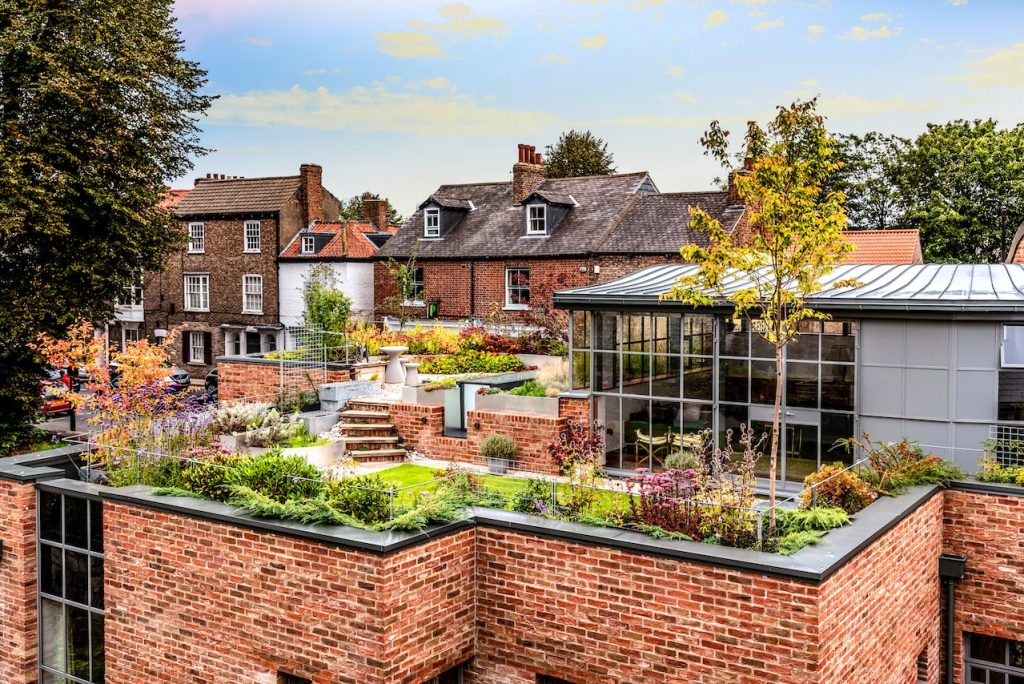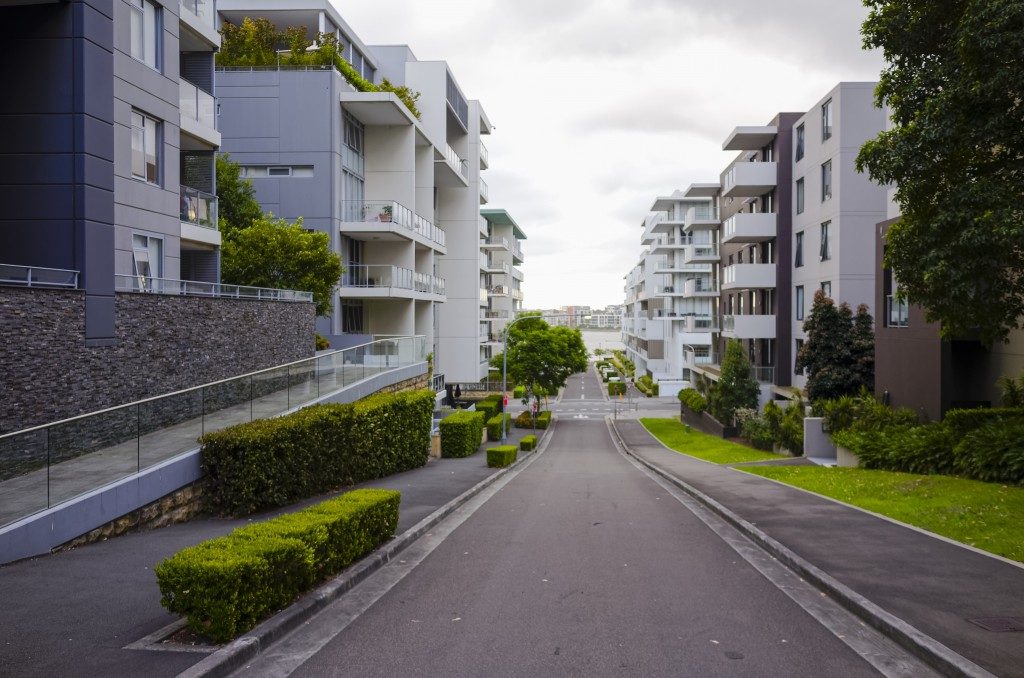Everyone can gain from cultivating a garden – it is a stimulating activity and helps maintain flexibility and mobility. Gardening also promotes using all motor skills, such as walking, bending, taking cuttings, reaching, digging, and planting seeds. Gardening bolsters endurance and strength while simultaneously reducing stress levels by providing relaxation. Furthermore, it creates interest in the outdoors which inevitably leads to a sense of contentment in the garden space.
Most homeowners set up a garden in their backyard. However, many overlook the potential of setting up a roof garden. Rooftops offer an opportunity to create a more versatile green space that can be used for recreational activities or simply as a means to retreat from the hustle and bustle of everyday life.
- Rooftop Gardens
- Things to Consider When Building a Roof Garden
- Consider Drainage
- Rooftop Garden Ideas
- Plant a Green Wall
- Set Up Raised Beds
- Create Flexible Roof Gardens
- Look for the Right Plants
- Set Up an Outdoor Living Space
- Install Suitable Lighting
- Create a Focal Point
- Add Privacy to the Roof Terrace
- Ensure the Safety of the Green Outdoor Space
- Create a Cozy Atmosphere with Accessories
- Frequently Asked Questions
Rooftop Gardens
People have been using their balconies and fire escapes to nurture plants for a long time. Even a green roof – one covered with soil and vegetation – has long been around. People always yearn for more garden space, which is why rooftop gardening has become widespread in residential and commercial sites. People even use the best backyard gardening tips when caring for roof gardens.
Things to Consider When Building a Roof Garden
If you plan to start a garden on the roof deck of your home, you should look for the best-rated garden features for your home. Before beginning your project, ensure you have the necessary garden tools and supplies. An important criterion for rooftop gardens is the material used to construct the garden bed. It should withstand heavy winds and rain, as well as temperature changes.
Consider Drainage
You can also consider other elements such as drainage, soil type, and light exposure. Finding the best roof garden ideas will also help you decide what kind of plants you should choose and how to maintain them. You should also set up an outdoor faucet and ensure the floor surface is non-slip. It would help if you considered installing a drip irrigation system to keep your plants healthy.
Rooftop Garden Ideas
Here are ten rooftop garden ideas to create your magical green getaway.
Plant a Green Wall
Planting a green wall is an excellent way to add texture and color to your rooftop garden. You can do this by mounting a trellis or wire mesh on the wall and then training vines to grow around it. Transform your otherwise dull brick or concrete rooftop into a lush paradise by installing an ivy plant or climbing hydrangea as you would wall décor. While it may take some time for the vegetation to fill in, the secret garden-like atmosphere will be worth every second of anticipation!
Set Up Raised Beds
If you’re looking for a creative way to use your roof, consider building raised beds adjacent to the walls. You can choose among wooden or metal structures–or go even further and construct concrete boxes with plenty of depth for tall shrubs and small trees.
For extra protection against potential damage from roots, install a waterproof membrane and another thick layer capable of blocking root intrusion. Alternatively, consider slightly elevated beds so plants won’t be able to penetrate the surface at all!
Create Flexible Roof Gardens
If you’re starting gardening on your roof, try experimenting with small containers! Moving plants around until they find their ideal spot is a great way to learn which types of flowers and vegetables grow best. Home container gardening is suitable for places that do not have enough space, such as a roof surface.
Additionally, when winter months come around, and temperatures drop too low for outdoor gardens, you can still enjoy the beauty of these plants by bringing them indoors – giving you an early start in springtime blooms.
Look for the Right Plants
When planning the layout of a terrace garden, it is paramount to remember that there will be no access to the ground soil. Subsequently, whatever you select for your rooftop oasis must rely solely on yourself and Mother Nature as sources of water retention. The situation calls for choosing plants that are both drought-resistant and sun-loving. The ideal flora selections may vary depending on your climate. However, by keeping these two requirements at the forefront of your mind when making decisions—you can ensure an optimal outcome.

Set Up an Outdoor Living Space
The concept of an outdoor living room has become incredibly popular recently. But you should not limit yourself to plastic patio furniture. Instead, use modern outdoor furniture to design a full room outside, including decorations and accents. This trend is perfect for roof gardens that have limited space or require low-maintenance upkeep.
Make your outdoor area feel like an extra living room by adding couches, armchairs, coffee tables, lighting fixtures, and an outdoor rug. You can even install an outdoor kitchen or bar complete with a refrigerator, gas or charcoal grill, and an entertainment system. With these additions in place and some beautiful plants to accentuate the view around them – voila! You are now ready with your oasis away from home.
But you need to check how much weight the roof can take. You should also know the local laws on weight restrictions for roof terraces. You should consult a roofing contractor or structural engineer before starting construction.
Install Suitable Lighting
Illuminating your rooftop garden during the evening is essential for a pleasant and inviting atmosphere. Strategically placing bright lights near stairwells or doors will create an eye-catching ambiance while also making the roof appear larger once nightfall approaches.
LED or solar-powered lights are a great way to conserve energy and generate less heat. Think about adding dimmer lighting along pathways and seating arrangements to create an intimate setting.
Create a Focal Point
A focal point is an eye-catching feature that can be anything from a water fountain, a tall tree, or even an artful assembly of potted plants. A water fountain, towering tree, vibrant pot of flowers, or simply a sculpture can also create an eye-catching point in the rooftop garden. These features will add interest and beauty to any space. The idea is to draw the eye and create an area where you can enjoy it from all angles.
Add Privacy to the Roof Terrace
If you have an outdoor balcony, then cultivating climbing plants as a way to create more privacy would be an inspiring notion. Clematis, Climbing roses, and English Ivy are some of the prime choices that come to mind! Additionally, bamboo screens, curtains, or wooden frames could provide additional options for adding seclusion. The important thing is setting garden roofs with plants or accessories that block views from adjacent buildings to protect your privacy.
Ensure the Safety of the Green Outdoor Space
Safety and security must be the top priority for any city roof garden plans, so make sure you don’t hang anything over the edge or place pots on ledges unless they are firmly secured. It is also important to verify with your local governing body – some jurisdictions may not have this activity.
Furthermore, Pergolas, trellis, wirework, or shade sails should be attached securely and in a manner that allows regular tightening of their fixings. Additionally, the balcony or terrace should abide by all safety regulations. You should also check prevailing winds and install windbreaks to reduce the impact of strong gusts. To minimize wind effects, you can also plant wind-tolerant shrubs, such as evergreens.
Create a Cozy Atmosphere with Accessories
Consider adding accessories such as outdoor furniture, decorative planters, birdhouses, and wind chimes to make your roof garden appear more inviting. Choose pieces that harmonize with your current decor and color scheme.
Finally, if you have children in your household, ensure they do not use the roof garden as a playground and keep hazardous plants away from them.
In summary, a rooftop terrace or garden is excellent for creating an outdoor oasis. But it is crucial to consider factors such as material, drainage, soil type, light exposure, plants, and accessories to ensure a beautiful and functional rooftop garden. With these tips, you can create the perfect rooftop garden of your dreams!
Frequently Asked Questions
What are some important safety considerations for rooftop gardens?
Safety should always be the top priority when building a rooftop garden. Check with your local governing body to ensure that your plans comply with safety regulations. Additionally, attach Pergolas, trellises, wireworks, and shade sails securely and in a way that allows regular tightening of their fixings. It would help if you also placed windbreaks to reduce the impact of high winds.
What are the critical elements of a rooftop garden?
When planning your roof garden, it is vital to consider the material used to construct the garden bed, drainage, soil type, light exposure, plants, and accessories. Ensure that you have the necessary tools and supplies to get started. Additionally, choose drought-resistant and sun-loving plants for the rooftop oasis. Finally, make sure to install suitable lighting and add cozy accessories to make the garden feel more inviting.
What are the best plants for a rooftop garden?
The type of plants you choose for your rooftop garden will depend on your climate. Some popular options include succulents, herbs, cacti, sedums, ferns, and vines. You can also consider ornamental grasses or flowering shrubs that thrive in outdoor conditions. Consider the sun exposure the roof gets and select plants best suited for the area.
What kind of planter boxes should you purchase for a rooftop garden?
When selecting planter boxes for your rooftop garden, choose one that is sturdy and can withstand the elements. Plastic or ceramic containers work well, as they are easy to maintain and move around. You could also consider metal containers if you want a more modern look. Make sure that whatever material you choose is lightweight so it won’t add too much weight to the roof.



